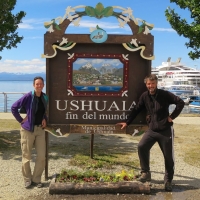 When we were at the end of the Carretera Austral and we looked out over the lake we felt that we had reached the end of civilization. Villa O’Higgins was the last village on the route and from this point there was only wilderness. On the map, however, we saw that we had not quite reached the end of civilization yet. On the other side of the mountains, in the southern most tip of Argentina we could visit Ushuaia, the southernmost city of the world. From Villa O’Higgins no less than 1,000km south! The coming days we will drive through Chile and Argentina on the “Ruta del fin del Mundo” to the end of the world!
When we were at the end of the Carretera Austral and we looked out over the lake we felt that we had reached the end of civilization. Villa O’Higgins was the last village on the route and from this point there was only wilderness. On the map, however, we saw that we had not quite reached the end of civilization yet. On the other side of the mountains, in the southern most tip of Argentina we could visit Ushuaia, the southernmost city of the world. From Villa O’Higgins no less than 1,000km south! The coming days we will drive through Chile and Argentina on the “Ruta del fin del Mundo” to the end of the world!
[Dear readers, much to my regret our blog is far behind. After much thinking, I decided to stubbornly keep writing, rather than to suddenly skip a part of our adventures. You will therefore now read about our adventures of December 2014, while we celebrated Christmas and New Year on our way to the end of the world]
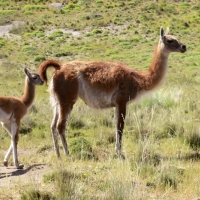 We begin our tour in National Parc Valle Chacobuco. Like Parc Pumalin, this parc was also emerged with the help of the rich American Douglas Tompkins. He bought the land, took down the farms and gave the land back to nature. All kinds of wild animals were introduced, including the endangered Chilean Huemul (a kind of deer), guanacos (a kind of llama) and even pumas! Despite a search for puma tracks, we mainly see guanacos. In the morning while we are packing our tent a large group of those brown-white beasts rans out of the bushes, eats some green grass and then gallops of the field again on the other side. They are funny looking creatures, with their long necks and woolly curly tail. And they are not shy at all. When we ride on the bikes through the park later that morning, they remain along the side of the road when we stop to take some pictures.
We begin our tour in National Parc Valle Chacobuco. Like Parc Pumalin, this parc was also emerged with the help of the rich American Douglas Tompkins. He bought the land, took down the farms and gave the land back to nature. All kinds of wild animals were introduced, including the endangered Chilean Huemul (a kind of deer), guanacos (a kind of llama) and even pumas! Despite a search for puma tracks, we mainly see guanacos. In the morning while we are packing our tent a large group of those brown-white beasts rans out of the bushes, eats some green grass and then gallops of the field again on the other side. They are funny looking creatures, with their long necks and woolly curly tail. And they are not shy at all. When we ride on the bikes through the park later that morning, they remain along the side of the road when we stop to take some pictures.
We drive through the park towards the border with Argentina to the border post at “Paso Roballos”. This border crossing is not very often used, which will have everything to do with the poor state of the road. For us the gravel road is just fine, but with a normal car it would be impossible to ride here. The border crossing therefore especially attracts adventurers in 4x4s or on motorcycles, who all leave their ‘signature’ on the glass window of the customs official in the form of a sticker. We see the sticker of our friends Megan and Matthew and in the book in which we have to register we read that our friends from Singapore were here just a few days ago.
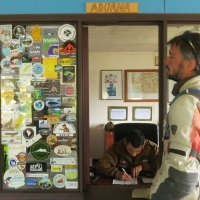 Once all the paperwork is completed, the gate is opened. We leave Chile and drive through no man’s land towards the border of Argentina. After about ten kilometers we park at some wooden buildings, where a sign states that we are at the Argentine customs. It looks more like a farm than a border post, because in the yard are some chickens and dogs, in the meadow are horses and a little further grazes a big herd of sheep. One of the customs officers opens the door and invites us inside. We are offered a chair and see how our data is recorded in a ledger. They do not use computers here and we doubt whether they have electricity. We are the first ones to cross the border today and in the recent days only a handful of other travelers passed through. The three men are the obviously happy that they have some “customers” and seem to like a chat. Once the paperwork on the Argentine side is completed as well, they wave us goodbye from the porch and we continue our way.
Once all the paperwork is completed, the gate is opened. We leave Chile and drive through no man’s land towards the border of Argentina. After about ten kilometers we park at some wooden buildings, where a sign states that we are at the Argentine customs. It looks more like a farm than a border post, because in the yard are some chickens and dogs, in the meadow are horses and a little further grazes a big herd of sheep. One of the customs officers opens the door and invites us inside. We are offered a chair and see how our data is recorded in a ledger. They do not use computers here and we doubt whether they have electricity. We are the first ones to cross the border today and in the recent days only a handful of other travelers passed through. The three men are the obviously happy that they have some “customers” and seem to like a chat. Once the paperwork on the Argentine side is completed as well, they wave us goodbye from the porch and we continue our way.
The day started sunny, but in the course of the morning the wind picks up. The dark sky and the uniquely shaped clouds above the rugged mountain peaks look very dramatic. Here and there we pass sheep farms with large herds of sheep, but apart from those ’estancias’ the area is scarcely populated. The rugged landscape is vast and from the motorbikes we enjoy the beautiful views. We even see a group of wild horses!
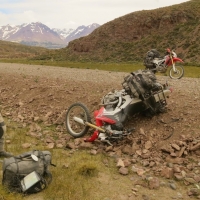 Because of all these beautiful things around us you would almost forget that we should also keep paying attention to the road. And that is when things go wrong. I have just pointed Peter to some beautiful rockformations, when I hear a yell over the intercom. I see the back of his bike come off the ground and see Peter flying off his bike over the handlebars. By looking at the rocks, he had not noticed the curve in the road and had hit the deep gravel. In an attempt to correct he drove off the road. It is silent for a moment, but then I hear over the intercom: “I am OK.” Fortunately, because it looked far from OK. Once we have both recovered from the shock and have made sure that Peter has not broken any bones, we take a look at the damage to the motorbike. One mirror has broken off, the rack on the handlebars is bent, the LED lamp is broken and there are some scratches on the plastic. Apart from that, everything seems to be straight. Nothing too bad. We put the bike back on the road, tie the bags on the bike, take a deep breath and then start riding again. A bit slower than before, especially in the curves.
Because of all these beautiful things around us you would almost forget that we should also keep paying attention to the road. And that is when things go wrong. I have just pointed Peter to some beautiful rockformations, when I hear a yell over the intercom. I see the back of his bike come off the ground and see Peter flying off his bike over the handlebars. By looking at the rocks, he had not noticed the curve in the road and had hit the deep gravel. In an attempt to correct he drove off the road. It is silent for a moment, but then I hear over the intercom: “I am OK.” Fortunately, because it looked far from OK. Once we have both recovered from the shock and have made sure that Peter has not broken any bones, we take a look at the damage to the motorbike. One mirror has broken off, the rack on the handlebars is bent, the LED lamp is broken and there are some scratches on the plastic. Apart from that, everything seems to be straight. Nothing too bad. We put the bike back on the road, tie the bags on the bike, take a deep breath and then start riding again. A bit slower than before, especially in the curves.
After 30km we reach the end of the gravel road and ride on asphalt again. We are back on Ruta 40, which we will follow towards the south. The distances between the villages along the route are large, so we are preparing for some long days in the saddle. It is for that reason nice to drive on asphalt again, because our average speed now is slightly higher than on gravel. Though for now we do not notice a lot of difference, because with the strong wind we struggle to keep our speed.
 From the moment we set foot in Argentina we have been warned by everyone for the wind in Patagonia. The Patagonian wind is legendary and is supposed to be strong enough to blow us off the road. On the Chilean side the wind was not so strong, but here on the Argentine side it is very strong. If the wind comes from the side, we lean against the wind with our full weight, the bikes in a strange angle on the road. Once the GPS indicates that we ride to the west, this usually means that we have to drive full into the wind. To keep a little momentum, we make ourselves as small as possible and lie flat on our tanks. Along the side of the road are signs that warn for the wind, but even on the parts without any of those signs, we have to be careful. Especially the unexpected blasts of wind are annoying, because they suddenly send us to the wrong side of the road. It is our luck that there is not a lot of other traffic here. Talking to each other is impossible, because we cannot hear each other due to the noise of the wind. And stopping by the side of the road is difficult as well, because the wind is indeed so strong that we have to put two feet on the ground to prevent us from falling over. On windy days like this we keep our heads down, open the gas and just ride.
From the moment we set foot in Argentina we have been warned by everyone for the wind in Patagonia. The Patagonian wind is legendary and is supposed to be strong enough to blow us off the road. On the Chilean side the wind was not so strong, but here on the Argentine side it is very strong. If the wind comes from the side, we lean against the wind with our full weight, the bikes in a strange angle on the road. Once the GPS indicates that we ride to the west, this usually means that we have to drive full into the wind. To keep a little momentum, we make ourselves as small as possible and lie flat on our tanks. Along the side of the road are signs that warn for the wind, but even on the parts without any of those signs, we have to be careful. Especially the unexpected blasts of wind are annoying, because they suddenly send us to the wrong side of the road. It is our luck that there is not a lot of other traffic here. Talking to each other is impossible, because we cannot hear each other due to the noise of the wind. And stopping by the side of the road is difficult as well, because the wind is indeed so strong that we have to put two feet on the ground to prevent us from falling over. On windy days like this we keep our heads down, open the gas and just ride.
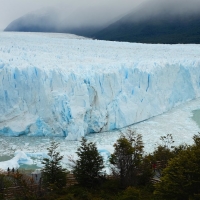 The first night we stay in a motel in Baja Caracoles and the day after that we ride a long, cold day into the wind to El Calafate. We will not ride to the end of the world in one go, but will make some side trips while riding south. The first trip is in El Calafate, where we visit the Perito Moreno glacier. It is a huge glacier which is fed from the Southern Patagonian Icefield. At the point where the big mass of ice enters the lake the glacier is more than 60 meters high and up to 5 kilometers wide! Truly a wall of ice! We can see the glacier from very close and can even hear the cracking of the blue-white ice. The glacier is still growing and because of that movement big chucks of ice fall down in the water. From a distance it seems to be only a small piece, but it can be pieces of 20 meters high and a few meters thick. As if a house collapses! We stay on a bench in front of the glacier for a few hours and see one piece after another fall into the water. Each time it creates a huge wave where huge chunks of blue ice are floating in. Very impressive!
The first night we stay in a motel in Baja Caracoles and the day after that we ride a long, cold day into the wind to El Calafate. We will not ride to the end of the world in one go, but will make some side trips while riding south. The first trip is in El Calafate, where we visit the Perito Moreno glacier. It is a huge glacier which is fed from the Southern Patagonian Icefield. At the point where the big mass of ice enters the lake the glacier is more than 60 meters high and up to 5 kilometers wide! Truly a wall of ice! We can see the glacier from very close and can even hear the cracking of the blue-white ice. The glacier is still growing and because of that movement big chucks of ice fall down in the water. From a distance it seems to be only a small piece, but it can be pieces of 20 meters high and a few meters thick. As if a house collapses! We stay on a bench in front of the glacier for a few hours and see one piece after another fall into the water. Each time it creates a huge wave where huge chunks of blue ice are floating in. Very impressive!
After a few days of camping in the center of El Calafate, we continue our journey to the south. Our destination at the end of the world, Ushuaia, is located in the extreme south of Argentina. You might say, “Just follow the Argentine roads to the south and then you will get there!” But it is not that simple, because to arrive in Ushuaia, we must first ride through Chile. And so we stand again with our passports in line at the customs office that afternoon, when we cross the border between the two countries for the fourth time. Once all the documents are stamped, we enter Chili at the end of the afternoon.
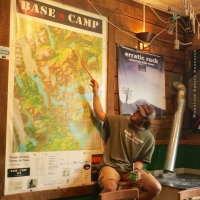 We ride to Puerto Natales, a small town at the sea from which we will make our second trip: a visit to National Park Torres del Paine. It is one of the most beautiful national parks of Patagonia and especially popular with hikers and climbers. On the way south we had been approached by several people asking if we would do the “W” or the “O”. It sounded like some sort of secret language. We had no idea what they were talking about until we found out that the hikes you can make in the national park have the shape of -yes- a ‘W’, an ‘O’ or even a ‘Q’ . Walking sounded like quite a nice change from riding the motorbikes, so we headed to Puerto Natales. That afternoon we find a place to sleep at Hostal Shakana, a pleasantly busy hostel with an equally bustling owner called Shakana. We can park the bikes in the yard and get assigned a bunk bed in one of the dorms. It takes some getting used to sleeping in a mixed dorm room full of 20-year backpackers, but with earplugs it is just fine.
We ride to Puerto Natales, a small town at the sea from which we will make our second trip: a visit to National Park Torres del Paine. It is one of the most beautiful national parks of Patagonia and especially popular with hikers and climbers. On the way south we had been approached by several people asking if we would do the “W” or the “O”. It sounded like some sort of secret language. We had no idea what they were talking about until we found out that the hikes you can make in the national park have the shape of -yes- a ‘W’, an ‘O’ or even a ‘Q’ . Walking sounded like quite a nice change from riding the motorbikes, so we headed to Puerto Natales. That afternoon we find a place to sleep at Hostal Shakana, a pleasantly busy hostel with an equally bustling owner called Shakana. We can park the bikes in the yard and get assigned a bunk bed in one of the dorms. It takes some getting used to sleeping in a mixed dorm room full of 20-year backpackers, but with earplugs it is just fine.
The next day we go to an adjacent cafe to attend a talk about the hikes we can do in the national park. An enthusiastic guide explains the different routes, advises on the equipment and provides helpful tips on camping en route. At the end of the talk, we have learned all the secret language and excited decide to take five days to hike the ‘W’. We each rent a backpack and a set of walking poles and use the afternoon to find the rest of our gear. The entire village breathes “Hiking”. In the supermarkets we can buy dried fruits and ready-to-eat meals where you only need to add water.  In the outdoor shops you can buy exactly the right shoes and clothes and when we explain in the pharmacy that we will go hiking the lady puts athletic tape and blister patches on the counter. At the end of the day two filled backpacks are next to our bunkbed. We are ready to go.
In the outdoor shops you can buy exactly the right shoes and clothes and when we explain in the pharmacy that we will go hiking the lady puts athletic tape and blister patches on the counter. At the end of the day two filled backpacks are next to our bunkbed. We are ready to go.
The next morning we sit down at 06:45 at the kitchen table, where Shakana is already happily making eggs for everyone. After breakfast we put our backpacks on our backs and walk to the bus station. We wait half an hour for the bus that will take us to the entrance of the park and then join a large group of tourists that are waiting for the catamaran. The boat will take us to the beginning of the walk. It is very busy. Tourists come from all over the world, we hear German, French, Spanish, Japanese and a lot of Hebrew. And everyone looks equally slick with large backpacks, lightweight tents, thermal clothing, down jackets, wind stoppers and beautiful hiking boots. It is a motley collection of very expensive equipment. After 1.5 hours of waiting, we take the boat and are dropped off at “Refugio Paine Grande”, the starting point of our hike.
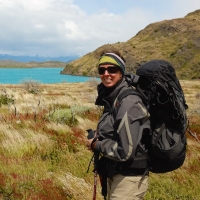 The first day we walk to Refugio Glacier Grey, a three to four hours hike with a decent height profile. We follow the path into the hills and leave the beautiful blue lake behind us. The wind is blowing very hard, so hard that I even tumble over a number of times due to the weight of the backpack! The walking poles we rented directly prove to be very useful, because they help us to stay upright. It is a beautiful walk, but we can both feel that a year on our motorcycles has not done our walking condition much good. We walk our own pace and regularly must move aside to let other faster hikers pass. We end up doing more than five hours over the walk to the campground and are pretty tired when we get there.
The first day we walk to Refugio Glacier Grey, a three to four hours hike with a decent height profile. We follow the path into the hills and leave the beautiful blue lake behind us. The wind is blowing very hard, so hard that I even tumble over a number of times due to the weight of the backpack! The walking poles we rented directly prove to be very useful, because they help us to stay upright. It is a beautiful walk, but we can both feel that a year on our motorcycles has not done our walking condition much good. We walk our own pace and regularly must move aside to let other faster hikers pass. We end up doing more than five hours over the walk to the campground and are pretty tired when we get there.
At the campsite the wind is blowing very hard. Several tents are ripped and flapping in the wind. Wow, it would not be good if that would happen to our tent! We find a sheltered spot for our tent, ensure that we can sleep and then cook some pasta in the communal kitchen. We both have sore feet and back into the tent it appears that Peter has especially large blisters. I was walking on rented shoes that fit quit well, but we had not been able to find shoes for Peter. We followed the advise of one of the guides to do the hikes on his palladium shoes. During the talk the day before we had also gotten the tip to take chocolate for those moments when you feel like giving up. When we are in the tent that night, it does not take long before the first bar of chocolate is open.
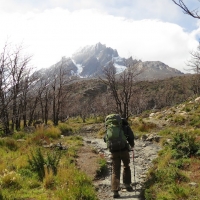 Luckily the wind does not cause many problems that night, so the next morning we can pack up our tent without any problems. We leave our big backpacks on the campsite for a moment and walk a little bit further to see the glacier we had been walking towards all day yesterday. The weather is a lot better today and that makes walking a little easier. It is a nice walk to the glacier and a good warming-up. The muscle pain we had yesterday is gone, but our feet are far from recovered. Back at the campsite we take our big backpacks and start hiking back to Refugio Paine Grande, with which we finish the left leg of the “W”. We start in good spirits on the way back, but after half an hour it is clear that we should stop our hike. It is beautiful to walk here, but due to the pain in our feet we can no longer walk normally. It again takes us more than five hours to walk back and with a thud we place our backpacks at the gangway to the catamaran. Another three days of walking to finish the “W” is not possible, so we stop after walking our “I”.
Luckily the wind does not cause many problems that night, so the next morning we can pack up our tent without any problems. We leave our big backpacks on the campsite for a moment and walk a little bit further to see the glacier we had been walking towards all day yesterday. The weather is a lot better today and that makes walking a little easier. It is a nice walk to the glacier and a good warming-up. The muscle pain we had yesterday is gone, but our feet are far from recovered. Back at the campsite we take our big backpacks and start hiking back to Refugio Paine Grande, with which we finish the left leg of the “W”. We start in good spirits on the way back, but after half an hour it is clear that we should stop our hike. It is beautiful to walk here, but due to the pain in our feet we can no longer walk normally. It again takes us more than five hours to walk back and with a thud we place our backpacks at the gangway to the catamaran. Another three days of walking to finish the “W” is not possible, so we stop after walking our “I”.
We wait half an hour for the boat and then another four hours for the bus that takes us back to Puerto Natales. It is 22:00 when we walk back from the bus station to the hostel. Now we have to hope that Shakana has a bed for us because he only expects us back in a few days and it is very busy in town, because it is Christmas Eve! Shakana open the door shouting “Merry Christmas!” and immediately tells us that he has a bunk bed for us! I cannot suppress a few tears. We throw our backpack and shoes in the corner of the room and prepare some food on our socks. 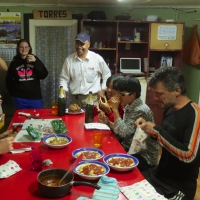 At that moment Christmas music is turned on, sparkling wine is opened and everyone is given a present by Shakana. The deeply miserable feeling of just a few minutes ago immediately gives way to a warm, fuzzy feeling! Merry Christmas!
At that moment Christmas music is turned on, sparkling wine is opened and everyone is given a present by Shakana. The deeply miserable feeling of just a few minutes ago immediately gives way to a warm, fuzzy feeling! Merry Christmas!
We stay a few days at Hostal Shakana, listening to Christmas carols and watching Christmas movies with our sore feet high up on the couch. In the evening we walk to the adjacent cafe with a group of other hikers where we celebrate Christmas with pizza and beer. Great fun!
On the third day of Christmas we get on the bikes again. Once we have left the touristy village behind us, we are back in the vast empty landscape with on both sides of the road just a few sheep farms. The wind still blows very strongly and has even given the trees a special shape. It is chilly, so we are wearing almost all our clothes: thermal underwear, two sweaters, riding suits, thick gloves and even our rain suits. This is the way to keep warm. That day we ride to Punta Arenas, a beautiful port city with a rich past. For a long time, certainly until the Panama Canal was built, the cargo ships sailed along Punta Arenas when they sailed around South America and this was a bustling commercial city. In the center of the city are beautiful old buildings that remind of those times. We stay a few days to look for new tires for the motorcycles and do some shopping. With new hiking boots, but without motorcycle tires, we start riding again after a few days.
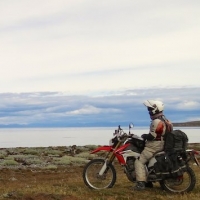 From Punta Arenas, we take the early ferry to Porvenir. The weather is beautiful and the water is -to my relief- very quiet. And we are lucky because now that the water is so smooth, we see dolphins and whales! After an hour we arrive at Porvenir and with that we have also officially arrived on Tierra del Fuego, the island in the southernmost tip of Patagonia. We follow a gravel road right along the water. It is a beautiful route, not in the least because we again see dolphins, that are hunting just a few meters from the shore. At the beginning of the afternoon we arrive in the hamlet of San Sebastian, where we cross the border between Chile and Argentina again. It is the first border post where the customs officers from both countries share one office. It is crowded and everyone seems to be in the party mood now we are around the holidays. The music is loud and the stamps are put in our passports while the officials are singing.
From Punta Arenas, we take the early ferry to Porvenir. The weather is beautiful and the water is -to my relief- very quiet. And we are lucky because now that the water is so smooth, we see dolphins and whales! After an hour we arrive at Porvenir and with that we have also officially arrived on Tierra del Fuego, the island in the southernmost tip of Patagonia. We follow a gravel road right along the water. It is a beautiful route, not in the least because we again see dolphins, that are hunting just a few meters from the shore. At the beginning of the afternoon we arrive in the hamlet of San Sebastian, where we cross the border between Chile and Argentina again. It is the first border post where the customs officers from both countries share one office. It is crowded and everyone seems to be in the party mood now we are around the holidays. The music is loud and the stamps are put in our passports while the officials are singing.
From the border we drive on the asphalt again in Argentina, so the average speed can go up again. If we can cover some distance today, we can be in Ushuaia tonight. We stop to refuel and are addressed at the gas station by two very enthusiastic Brazilians, José and his son Arthur. They are themselves making a road trip through Argentina and Chile and sleep on a mattress in their van. José is fanatical enduro rider and they both are crazy about motorcycles. Before we know it we are talking for a long time with them about the Dakar Rally that they follow every year. Great to hear. We make some pictures, get stickers and even a t-shirt and then say goodbye. We now need to drive again if we still want to arrive in Ushuaia today. They are also on the way south, so perhaps that we meet there.
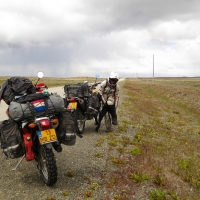 We follow Ruta 3 to the south and ride right along the Atlantic coast. It is flat, barren, windy and actually a little boring. We keep the average speed high. About 100 km before Ushuaia the lanscape begins to change and we see a lot of trees. Much nicer! It has been raining hard and by the time we arrive in Ushuaia, we are both very wet. The weather is so bad that we do not want to camp, but try to find a warm bed instead. We first try staying at the hostel where our friends Stuart and Nicola (who we had met on the ferry to Villa O’Higgins) are staying, but that hostel is full. The owner sends us to an adjacent hostel where we miraculously find the last two beds. Very nice! Tired from a long day in the saddle, we go to bed early.
We follow Ruta 3 to the south and ride right along the Atlantic coast. It is flat, barren, windy and actually a little boring. We keep the average speed high. About 100 km before Ushuaia the lanscape begins to change and we see a lot of trees. Much nicer! It has been raining hard and by the time we arrive in Ushuaia, we are both very wet. The weather is so bad that we do not want to camp, but try to find a warm bed instead. We first try staying at the hostel where our friends Stuart and Nicola (who we had met on the ferry to Villa O’Higgins) are staying, but that hostel is full. The owner sends us to an adjacent hostel where we miraculously find the last two beds. Very nice! Tired from a long day in the saddle, we go to bed early.
When the next morning we sit at our breakfast, we are visited by Stuart and Nicola. They had thought they could stay in the same hostel another night, but they had been told that their room was double booked and they had to leave. Not very nice, especially on New Years Eve! They had already walked around the village, but all the other hostels were full. Instead, they have rented a tent, sleeping mats and sleeping bags and decided to go camping with us in the National Park Tierra del Fuego, to celebrate the New Year together. Nice! Mid-morning we drive to the campsite. It is a beautiful place in the woods overlooking a river and hills beyond.
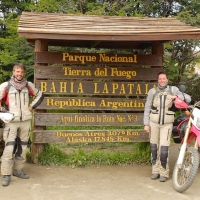 Once the tents are pitched, there is still one thing to do: ride to the “end of the world.” Ushuaia is the southernmost city in the world, but with the motorbikes we can go a bit further south to Bahia Lapataia. That will be really the end, because that is where Ruta 3 stops. It is thus the southernmost point of our trip. In Bahia Lapataia is a sign where we park our bikes next to, to make an official portret. Surely great to be here!
Once the tents are pitched, there is still one thing to do: ride to the “end of the world.” Ushuaia is the southernmost city in the world, but with the motorbikes we can go a bit further south to Bahia Lapataia. That will be really the end, because that is where Ruta 3 stops. It is thus the southernmost point of our trip. In Bahia Lapataia is a sign where we park our bikes next to, to make an official portret. Surely great to be here!
Back at the campsite, it is now a lot busier. A large number of Argentines with their family came to the campsite to celebrate New Year’s Eve. And celebrating they do, of course, with a large piece of meat on the grill, tasty wine and loud music. It is a lovely mess. Between all those cars we see the white van of José and Arthur, the Brazilians we encountered a day earlier at the petrol station. Great! Swinging to the music of our neighbors, we eat together and we talk it until the sun goes down. 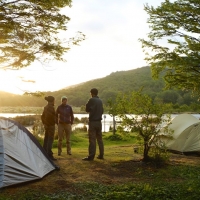 And that is long because we are now so far south that the sun only sinks until well after 11 pm. At 12 o’clock we count down in five different languages and we toast with our plastic mugs high in the air! A great evening and very cool place to start the new year!
And that is long because we are now so far south that the sun only sinks until well after 11 pm. At 12 o’clock we count down in five different languages and we toast with our plastic mugs high in the air! A great evening and very cool place to start the new year!
We start the next morning with a hearty breakfast and then wave our friends goodbye, because all four ride back to the north. We stay one more day at the campsite and then drive back the next day to Ushuaia. This time we have better luck finding a place to sleep. And it just so happens that there are in the same hostel eight bikers: an Englishman, one Canadian, two Italians, two Americans and two Russians. It remains funny how the conversations from that moment only go about tires, oil, fuel consumption and the best routes to drive.
The next morning we let the bikes for what they are and walk around through Ushuaia. We walk along the promenade and look at the water from the harbour. From here it is only a short way to Antarctica and the South Pole. Wow, this really feels like the end of the world. Cool to be here!
Distance traveled to Ushuaia = 40.664km (25,267 miles)
Previous story “Carretera Austral (Part II)” – Next story “Stop and GO“





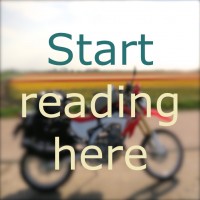


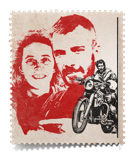
Wat een avonturen weer! Heerlijk om te lezen. Liefs.xx
Wowwowow, die gletsjer! echt rete-gaaf! En prachtige lupines in de berm. Hopelijk zijn de blaren weer helemaal weg en zit er weer een nieuw spiegeltje op de motor. Lekkere dikkertjes ook, die ganzenkuikens, moet ook wel, anders waaien ze natuurlijk zo weg 😉
Dikke kus, Leon en Celine
Hoi leonie en Peter.
Blijf zeker volhouden met de mooie verhalen te schrijven. Wij genieten er iedere keer weer van en vertellen ook andere van jullie mooie verhalen. We zien al weer uit maar het vervolg. Joke en Janleen
Als we toch zo ver achterlopen……GELUKKIG NIEUWJAAR!!!!
Ik heb weer genoten van “mijn” reis naar het einde van de wereld vanuit de luie stoel…bedankt!!!
Gelukkig heb je dit stukkie niet overgeslagen; had het niet willen missen! Xxx